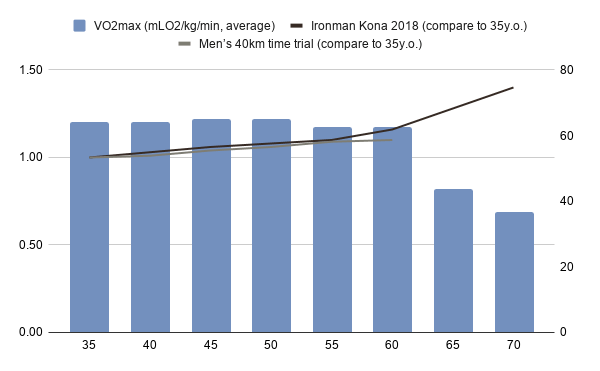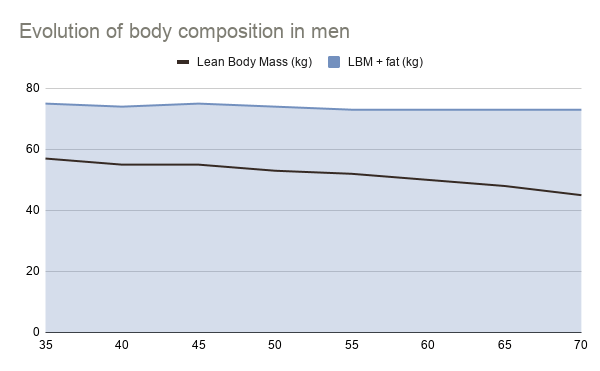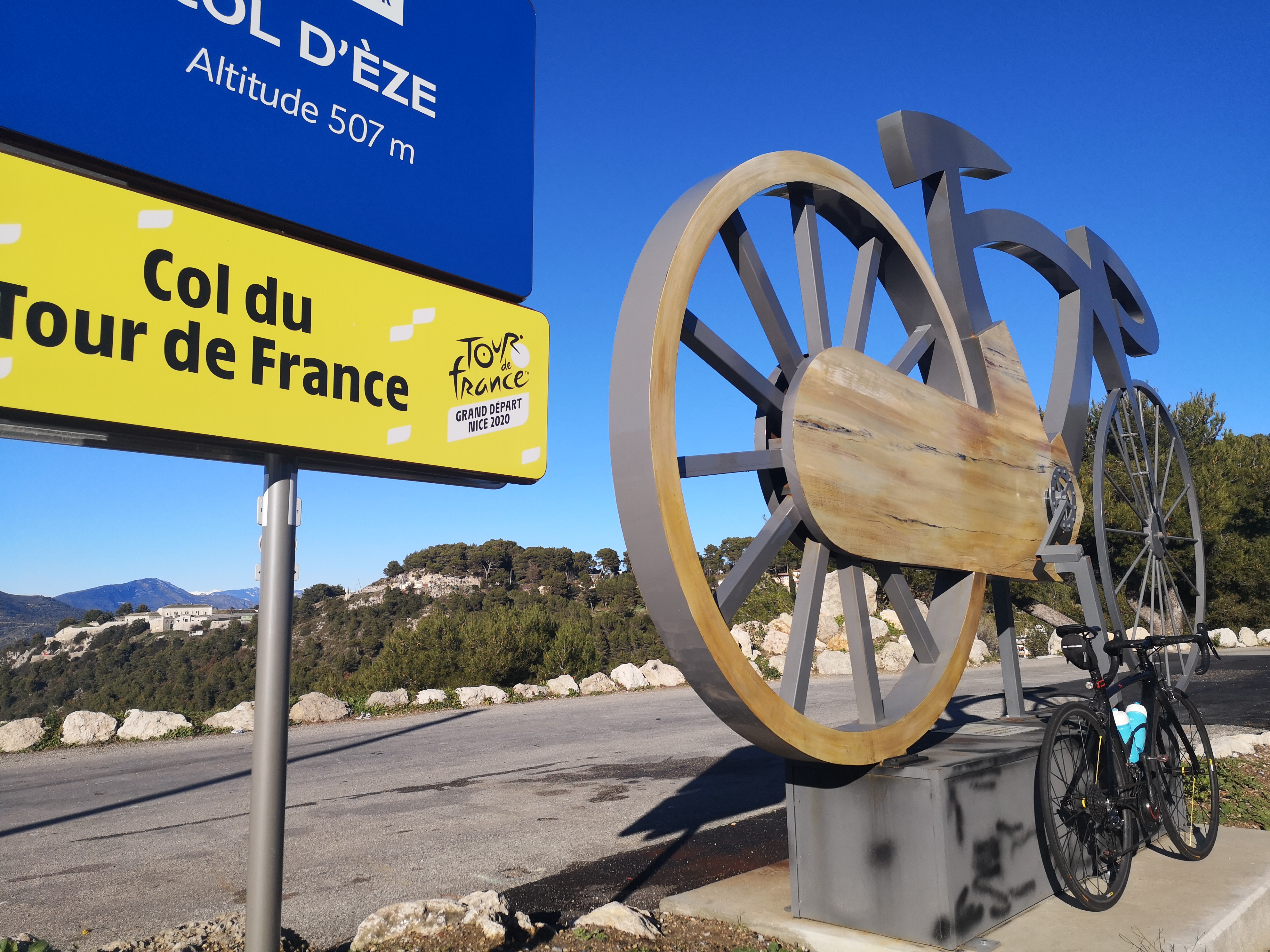As we get older, our body changes (it actually changes every single day !): the way we train needs to adapt to take these changes into account (click here to discover our specific winter training plan for Master’s athletes !). The popular belief is that age is necessarily linked to a decline in sport performance, as well as a decline in overall health. Aging hasn’t been clearly defined by science, but researchers have made a compilation of different symptoms of aging seen in the average population; not many studies have been able to follow athletes as they age because this research would take many years to be done as science follows athletes, and because baby boomer athletes just start aging and giving science a population to study. Studying aging women is even less studied, please refer to this article about master’s female athletes; this article only refers to male bodies.
What happens when you become older ?
In general (and again, it is for the overall population, these items are not specifically related to athletes), what has been seen in the average population is a loss of skin’s elasticity (wrinkles here we come !), reduction of hair pigment cells (gray hair), reduction in hearing high-frequency sounds, reduction of sleep time, loss of bone minerals, reduction in basal metabolic rate (with fat gain associated).
An athlete would feel some markers of aging which wouldn’t be necessarily noted by a sedentary aging person :
- a VO2max (aerobic capacity) decline
- a change in body composition (accumulation of fat and loss of muscle fibers).
In Fast After 50, Joe Friel reminds us that the overall trends for endurance performances are that between 20 and 30 years old, the performances improve rapidly, with a peak around 30. After 30 (+/- 5 years), a decline in performance appears which can be unnoticed at first thanks to improvements in economy or strategy, after age 40 the trend becomes clearer and even the very best athletes in the world slow down as they get older, and that the decline in performance is more important after age 60 (Randsell, 2009). However, these changes are not necessarily all limiting your performance : if you are willing to compete and express your best potential, it is important to remember that a characteristic of your own physiology will only be a limiter of your chances of success if the event requires this specific characteristic to be highly tuned : know thyself and understand the requirements of the event to train smarter !
Why is your aerobic capacity declining ?
The aerobic capacity (VO2max) is the ability of your body to process oxygen when exercising at a sustained maximal workload : it is how much your heart pumps oxygen towards your muscle, and how efficient your muscles are in using this oxygen; the power output is called the Maximum Aerobic Power (MAP) and is often measured during 5 minutes all-out efforts or ramp tests. Your VO2max potential depends partly on your genetics (Bouchard, 1986), the VO2max depends also on the sports (running will induce higher VO2max than cycling because bigger muscle groups are used), on the size and body weight. The below chart shows the performance of the best athletes in the USA 40km time trial (Randsell, 2009) and in Ironman Kona 2008, as well as the average VO2max of fit male cyclists (Friel, Fast after 50).
 Tanaka and Seals have demonstrated in several studies that the most important factor in performance decline in endurance athletes is the decrease of aerobic capacity. This can be due to a lack of contractility of the heart left ventricule, or to the reduction of maximal heart rate (even though this study found no change in maximal heart rate over 8 years), to changes in lung capacity, aerobic muscle enzymes, blood vessel elasticity, capillary density, …
Tanaka and Seals have demonstrated in several studies that the most important factor in performance decline in endurance athletes is the decrease of aerobic capacity. This can be due to a lack of contractility of the heart left ventricule, or to the reduction of maximal heart rate (even though this study found no change in maximal heart rate over 8 years), to changes in lung capacity, aerobic muscle enzymes, blood vessel elasticity, capillary density, …
Hard to know when these physiological parameters evolve in you.. Luckily, there is an even better predictor of the performance decline in aerobic capacity : changes in training as they get older. Many studies (Seals, 1984 ,Hawkins, 2001) have demonstrated that
- older endurance athletes who stop training at VO2max loose relatively as much aerobic capacity as sedentary people with age
- older endurance athletes who keep training at VO2max do not loose as much aerobic capacity.
Why are your muscles shrinking ?
Science has coined a specific term for this process which starts around 40: sarcopenia is the loss of muscle as normal people age. It is mainly due to the reduction in hormones production which are tightly related to muscle growth : testosterone, growth hormone and insulinlike growth factor.  After 40 years old, the production of these hormones decrease (Waters, 2003), which makes it harder to build muscles without external stimulation/training.
After 40 years old, the production of these hormones decrease (Waters, 2003), which makes it harder to build muscles without external stimulation/training.
Other studies have demonstrated that exercice alone does not maintain muscles, these muscles need to be strenuously strained if you want to keep them. The good news is that you can gain muscle mass at any age (Chalé, 2013) ! On this specific topic, your lifestyle (training and food intake) seems to play more important part than nature alone, as with the decline in aerobic capacity.
Why is your body accumulating fat as it ages ?
A shift seems to appear in body composition around 65 years old in the general population (Rolland-Cachera, 1991). In the above chart, we can see the lean body mass line in brown, with stacked above it the fat mass : even if the sum of both is fairly constant, we can see that with age the fat mass increases at the expense of the lean body (or muscle) mass (data extracted from Forbes, 1970). The reason for this change seems to be a complex process involving the activity of an enzyme called lipo-protein lipase (LPL) which isn’t very active in men at younger ages, but with getting older and testosterone levels being reduced, the LPL activity and your insulin sensitivity increase so that we can then expect an increase in fat deposits where the LPL activity is the most intense (Yost, 1993).
Proud of getting older : train smarter and go faster !
Now that you understand a bit more how age can influence your endurance performances, let’s see how to take that into account to train your older body and get the best out of it.
Love these VO2max sessions: train our older aerobic capacity
One of the best way to increase aerobic capacity is to train it specifically : these sessions are intense and have to be followed by the right amount of recovery. You also need to be careful on the frequency of these high intensity sessions : as ou age, recovery becomes harder and by doing too many VO2max sessions too often the risk of overtraining is real.
If you have been doing VO2max sessions regularly throughout your training years, then keep doing them but reduce their frequency to one, or maybe two a week during specific training cycles.
If you are new to high intensity training, be conservative and observe how you recover from your sessions : don’t increase how strenuous the next session will be if you couldn’t recover from the last session. A good session to start training our aerobic capacity would be to include the following intervals (after a proper warm-up and before a thorough cool down, of course !)
- 10 x (30 seconds at Max Aerobic Power / 5min power + 30 seconds recovery) : this is NOT a 30 seconds max sprint effort, it’s a strong effort but done at your 5 min power or 10% less.
To increase the training dose, you can increase the duration of the intervals at MAP, and then the total time at MAP over the entire workout. A progression could then be

More important than doing all of these sessions, is that you do them regularly : start by doing one every other week, notice how you feel afterwards and a few days after, if you feel that your body handles it well enough, start doing one a week, but keep a record of your recovery, this is what is going to determine if and when you do the next one. Our specific Master Winter Training Plan includes these workouts in a structure which allows you to make progress throughout the winter season.
These sessions will also help increase our lactate threshold power (FTP) (Coyle, 1995), and if your limiter for the even you prepare is your FTP, then it is important to keep training at sub-threshold (sweet spot) intensity
Love the gym sessions : train your older muscles
There is some debate on the importance of weight lifting for endurance athletes and especially for cycling. When getting older though, the situation is slightly different : we have seen that hormone levels useful for muscle growth were naturally decreasing, which means that you need to put an external stimuli on your body to increase its production of testosterone, growth hormone and insulinlike growth factor. How do you tell your body to produce these hormones ? By lifting weights (Vingren, 2010)! The other important thing is to ensure proper protein intake around your training sessions.
The older you get, the more you need to ensure spending the proper time each week to
- train your older core
- train specifically your older legs with movements close to the movements made during cycling.
What is proper time ? One or two sessions per week are enough to slow muscle loss (Häkkinen, 2003) ! The same rule of steady progression applies with strength training : start with low weight and doing 20 to 30 reps of the movement. Please refer to our specific article on strength training for more information on the progression.
Eat and sleep well : take care of your older body
Training is the combination of stress AND recovery, recovery being eating and resting. As we have already noted, take in more proteins each day and especially after your strength sessions as you age (0.93 to 1.2 g of protein per kg of body weight and per day Bauer, 2013, Tremblay, 1994).
Another important parameter to take into account considering the hormonal changes the body goes through is the Glycemic Index of the food you eat : reducing the amount of food you eat with high glycemic index will help reducing body fat -either because of a direct mechanism or because of limiting the cravings associated with high glycemic index foods (Gilhooly, 2007).
Lastly, maximising sleep time and sleep quality is essential for endurance performance with age. The usual recommendations apply here : eating your last dinner early enough before hitting bed, limiting caffeine and alcohol in the afternoon, limiting the use of screen devices in bed. Sleep is an important part of your recovery as this is the time when anabolic hormones such as testosterone and growth hormones are released : make a point in taking care of your sleep as much as you take care of your workouts on the bike !
Find more and get ready for training with our Master Winter Training Plan. I highly recommend reading Fast After 50, a training bible for any endurance athlete !






